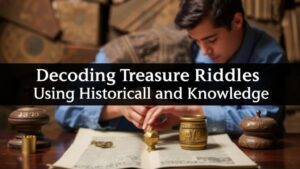Using Palindromes and Symmetry in Clues to Unlock Treasure Locations
Using Palindromes and Symmetry in Clues to Unlock Treasure Locations
The search for treasure is often fueled by not just the allure of hidden wealth but also the intellectual challenges posed by the clues left behind. Among the most intriguing clue types are palindromes and symmetrical patterns. Each carries with it a richness that extends beyond mere words and shapes, often offering deeper insights that can guide treasure hunters to their ultimate goal. In this article, we will explore how these intriguing linguistic and mathematical phenomena can be instrumental in deciphering treasure maps and clues.
Understanding Palindromes and Their Relevance
A palindrome is a word, phrase, number, or any sequence of characters that reads the same forward and backward (e.g., racecar or A man, a plan, a canal, Panama!). In the world of treasure hunting, the use of palindromic clues can serve as a red flag that a particular piece of information carries significance or a hidden meaning. The presence of a palindrome can indicate that the treasure is located in a space that embraces symmetry or balance.
For example, consider a treasure map that provides the following clue: “Seek the point where the sun rises twice.” If interpreted through the lens of palindromic nature, this could suggest a location that is reflected in some manner–perhaps a landmark that appears similar from various angles or a specific time of day when shadows and light create a visual palindrome. Looking to the actual positions and configurations of landmarks in the environment can reveal hidden meanings in these clues.
Symmetry in Nature and Structures
Symmetry is a fundamental principle in both art and science, evident in natures blossoms, human anatomy, and man-made structures. The relevance of symmetry in treasure hunting is twofold: it helps in understanding the physical layout of locations and the aesthetic intentions behind artistic or architectural designs. In the context of treasure maps or clues, symmetry can indicate that certain features are important or contain secrets.
For example, if a treasure map indicates the location of “three trees arranged in a perfect triangle,” hunters could infer that the symmetry of this arrangement serves a purpose. As an illustrative example, the practice of laying out gardens, buildings, or even historical landmarks has often utilized symmetry to suggest themes of harmony and order. This can be particularly prominent in cultures that value symmetry–such as the ancient Greeks, who closely tied their treasures to the architectural symmetry of temples.
Case Studies: Successful Deciphering Using Clues
- The Beale Ciphers: One of the most famous cases involving palindromic clues is the Beale Ciphers, a set of three ciphertexts allegedly revealing the location of buried treasure in Virginia. Clue number one uses a series of numerical codes that, when interpreted, reflects both palindromic and symmetrical properties in the distribution of locations described.
- The Oak Island Mystery: The infamous Oak Island treasure mystery has involved countless clues, many of which feature elements of symmetry in the geometrical arrangements of legendary artifacts. Enthusiasts have noted that the recurrent triangular formations and recursive patterns in the trees and land have been central to various theories regarding the treasures location.
Practical Applications for Treasure Hunters
Treasure hunters can benefit from integrating the principles of palindromes and symmetry in their search for locations. Here are some actionable takeaways:
- Analyzing Maps: When examining any map, look for palindromic phrases or symmetrical landmarks. These clues might suggest areas that deserve further exploration.
- Utilizing Technology: Use aerial photography or drones to uncover symmetrical patterns in natural landscapes, which may guide you to treasure locations.
- Cultivating a Critical Eye: Practice viewing spaces holistically. Often, treasure clues require you to think beyond words and into the spatial relationships of features.
Conclusion
The use of palindromes and symmetry as tools for deciphering treasure location clues taps into both linguistic nuance and mathematical beauty. Understanding these concepts can expand the resources available to treasure hunters, leading to more effective searches and a greater appreciation for the intricacies embedded within the environments they explore. By recognizing and leveraging these elements, enthusiasts can refine their search strategies and potentially unlock the secrets of hidden treasures.



